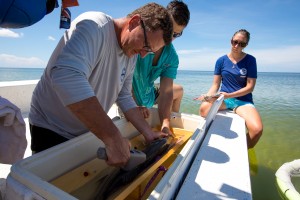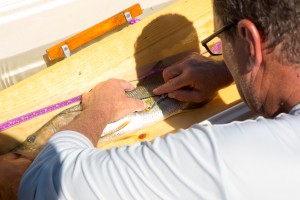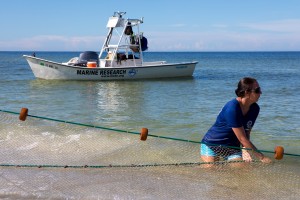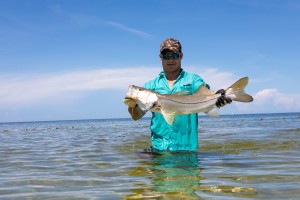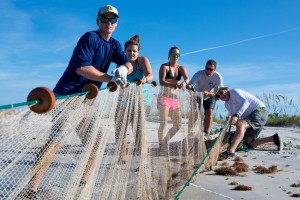Mote studies how snook in Boca Grande are faring amid red tide
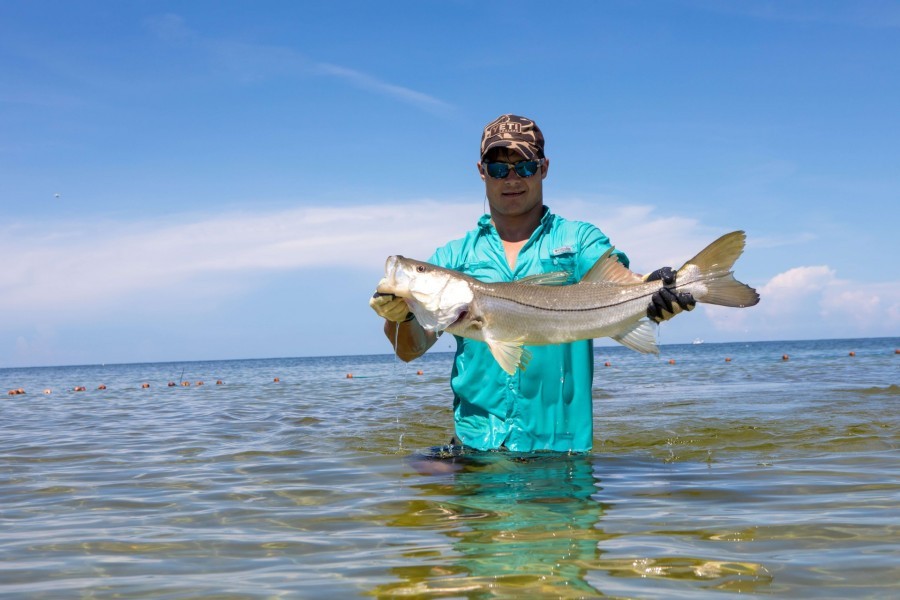
Mote volunteer Garrett Stephens holds a snook caught and released during the survey. Credit: Conor Goulding/Mote Marine Laborato
End-of-year update (December 2018)
Preliminary results: Snook rapid assessment during 2018 red tide along Boca Grande
When spawning snook perish from Florida red tide, other adult snook may re-occupy their spawning sites rapidly after conditions improve, according to Mote Marine Laboratory’s August 2018 rapid assessment of Boca Grande spawning sites.
Florida red tide killed many spawning, adult snook in June and July along Boca Grande beaches. In late August, during a temporary decrease in red tide concentrations along local beaches, Mote researchers caught, measured, tagged and released snook along multiple sites on Gasparilla and Little Gasparilla islands. Their preliminary results hint at the resilience of this prized sportfish species.
“In a relatively short time span, we found spawning-condition snook at the beaches where we had seen high mortality in June and July,” said Mote’s Fisheries Acoustics & Habitat Ecology Program Manager Dr. Jim Locascio, who led the survey. “We don’t know if the snook we found were individuals that left and came back, or if groups of individuals cycle back and forth through that site. We do know that snook can enter creeks with fresh water that isn’t conducive to Florida red tide, so some individuals find refuge. We also know that, once local conditions improved along these beaches, the snook reoccupied them.”
Detailed results will be finalized by January 2019. With this short-term, pilot study as a starting point, Mote scientists are seeking support to survey snook annually along these important spawning sites.
Though Mote scientists were pleased to observe spawning snook re-occupying some beaches, this year's red tide bloom has re-strengthened and persisted along many parts of southwest Florida, killing countless fishes of numerous species — and its impacts are still unfolding. Continued studies of wild fish populations, Florida red tide dynamics, and fisheries enhancement strategies to aid recovery are vital.
---
Original story
Mote Marine Laboratory scientists are conducting rapid assessment surveys of the status of common snook, a major Florida sport fish, in two areas that have experienced high fish mortality during the ongoing bloom of Florida red tide: Gasparilla Island and Little Gasparilla.
On Aug. 28 and 29, Mote scientists launched their survey efforts along the shore of Gasparilla Island.
Florida fisheries have been hit hard by the ongoing Florida red tide bloom, including adult snook present on their spawning grounds during summer months along Charlotte and Lee county beaches. Snook are an important part of Florida’s multi-species, saltwater, recreational fishery, which as a whole contributes $8 billion to the state’s economy.
Mote's rapid assessment of snook spawning stock, supported by emergency funds issued by the State of Florida this month, is needed to determine impacts to this important fishery and to develop more strategic stock enhancement actions to ensure recovery of this population as quickly as possible. Mote has advanced stock enhancement research with common snook for decades at Mote Aquaculture Research Park in eastern Sarasota County, developing sustainable recirculating aquaculture technology to breed and raise snook, while advancing strategies to release snook in an ecologically responsible manner and enhance their chances to survive and contribute to the fishery.
During the rapid assessment, Mote fisheries scientists and trained volunteers are catching, counting, measuring, tagging and releasing snook. Data collected this year will help scientists understand the recovery trajectory of the stock in future years.
From a boat along shore, Mote scientists and trained volunteers deploy a 600-foot beach seine net, enter the water and pull the net toward shore. Fish are funneled into the bag at the center of the net, allowing Mote scientists to count and measure snook, attempt to determine their sex, insert PIT tags (passive integrated transponders similar to the microchips used with pets), and release the fish. PIT tags hold key information about an individual fish and can be scanned to recover data if the fish is recaptured.
